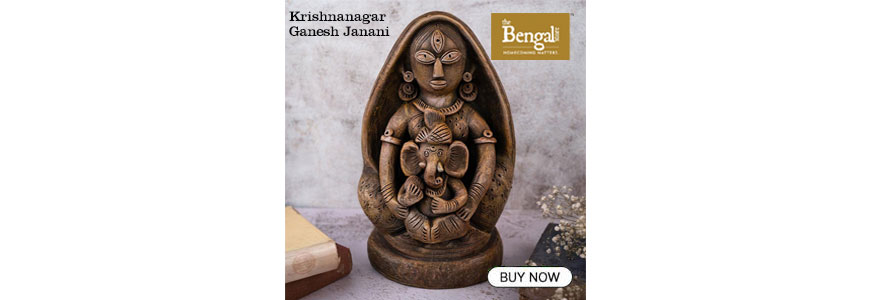250-year-old Puja that moved back from Narail in Bangladesh
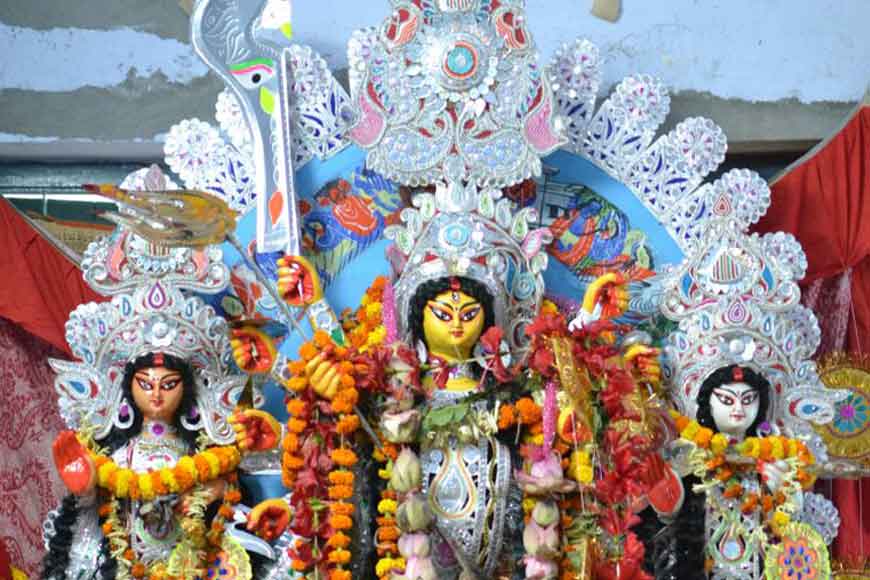
When a family moves from the Dutch colonial town of Chinsurah on the banks of the Hooghly to a prosperous rural belt of Narail in present day Bangladesh, then their worshipping Maa Durga also changes geographical boundaries. One such grand puja that again shifted back in the ‘60s from Opar Bangla to Epar Bangla is the Dwarikanath Bhadra Barir Pujo. Steeped in history that spans over 250 years, this puja has a history of both struggle and prosperity.
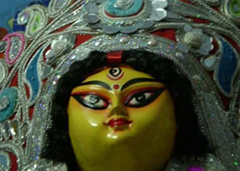 It was started by Ramanarayan Sen of Chinsurah who shifted to Narail around 1740 CE and joined a well-paid job in the Narail Raj Estate. Soon he became a favourite of the Rajah and the Rajah gifted him the jaigirdari of Maharajpur estate. Ramanarayan also successfully branched into business of pan, coconuts, paddy and banana. He became popular in his new homeland for his benevolence and wisdom, so much so that he was conferred with the title of ‘Bhadra’ that in Bengali means gentleman.
It was started by Ramanarayan Sen of Chinsurah who shifted to Narail around 1740 CE and joined a well-paid job in the Narail Raj Estate. Soon he became a favourite of the Rajah and the Rajah gifted him the jaigirdari of Maharajpur estate. Ramanarayan also successfully branched into business of pan, coconuts, paddy and banana. He became popular in his new homeland for his benevolence and wisdom, so much so that he was conferred with the title of ‘Bhadra’ that in Bengali means gentleman.
Later, his successors replaced their original surname, Sen, with the new title Bhadra and started using it. Ramanarayan’s immediate successors, his son Ramram Bhadra and grandson Kaliprasanna Bhadra, unfortunately were not as capable as their father and grandfather. They could not keep the zamindari properly and lost their estate. But they could successfully maintain their business and retain their wealth and prosperity. However, Kaliprasanna’s son Dewan Ram Bhadra and grandson Dwarikanath Bhadra were persons of remarkable intelligence and brought back the lost glory to the family lineage.
Dwarikanath Bhadra was the legal advisor to the Dutta Roy dynasty of Narail and a learned advocate. So was his father Ramram in the district civil court as well as to Narail Raj Estate. Dwarikanath was not only successful in his profession, as a human being he was respected for his benevolence and donated much to the development of educational institutions in the area. His donations even went into building of many temples and even mosques. Dwarikanath was the honorary head of many educational institutions. He had three sons — Kailaschandra , Bishnucharan and Atulkrishna and four early-widowed daughters — Bindubasini, Raikishori, Brindeshwari and Bishnupriya. Kailaschandra became a sannyasi, took the name of Shrimad Gopaldas Babaji and lived in Shantipur. Bishnucharan married thrice — Basanti Devi , Rajlakshmi Devi and Pankajini Devi. Basanti gave birth to three daughters — Rukmini, Satyabhama and Manitara — who were scholarship-holders of their time and Pankajini had one son, Kushalnath, a triple MA. Rajlakshmi had no offspring.
Till early ‘60s the family of the Bhadras lived in Bangladesh and tried to hold on to their traditional puja. But in 1964, Kushalnath was forced to relocate to Indi, after being brutally attacked by some religious fundamentalists. Until they left Bangladesh, in East Pakistan they had been living at their palatial building with temples and a chouchala in their own taluk, Kamalapur, since 1760 beside the river of Kumar where they owned huge bighas of land. Dwarikanath was awarded 3 parganas by the Narail Rajah, Joynagar, Bhabrasur and Telihati and Bishnucharan was given the pattanidari of the tauzee no.34 by the British. They also had houses in Dhaka, Shantipur and Shobhabazar.
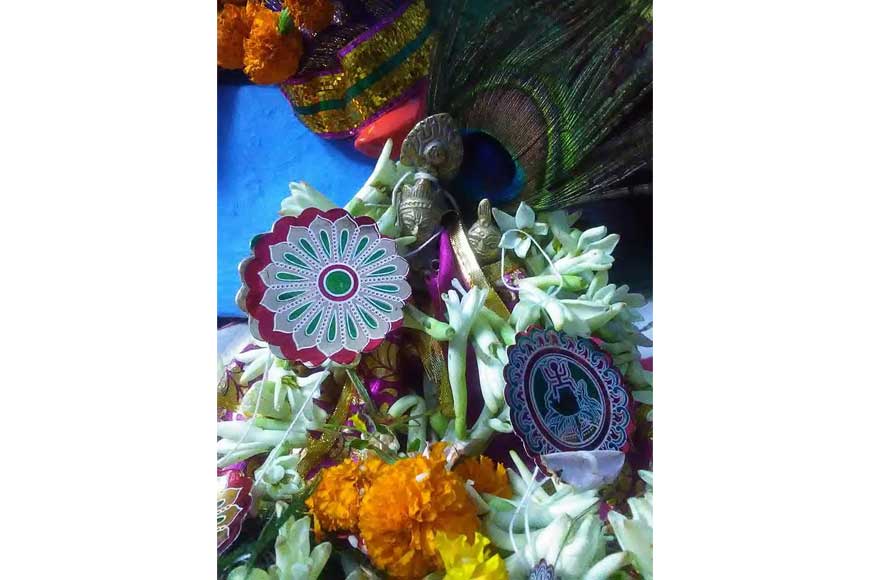
The Puja that was started in the year of 1760 CE by Ramanarayan in Kamalapur, that lies in present-day Faridpur of Bangladesh, continued there till 1966. However after the relocation of the family to India in 1966, it had to be shifted to India. Due to lack of space in the newly relocated dwelling, the family for few years could not worship their iconic idols. Instead they had to introduce Patachitra or Pat er Durga and continued the tradition of their Durga Puja. Then gradually over the years, The Bhadra Barir Pujo regained its past glory and grandeur.
This Puja has many unique rituals. The tradition follows the proceedings of the Devipuranam to invoke the goddess. The idol is the traditional Bengal Ekchala and unlike some other East Bengal families, Kartikeya and Ganesha do not interchange their places. Generally, Maa Durga and her daughter Goddess Lakshmi are coloured in the same shade but in this household, Durga is Golden (Taptakanchanbarna) while Lakshmi is pinkish (Shyamala). Chalchitra is illustrated with the motifs of Shivabrata. Bodhan is done on the eve of Shashthi.
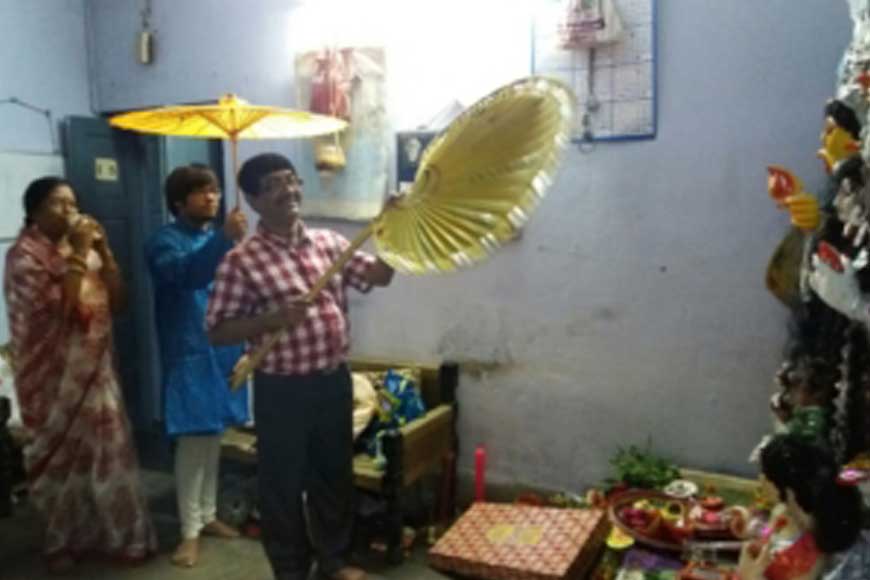
As bhog, cooked rice is offered to the Goddess from Saptami – Dashami and on Navami, cooked hilsa and rohu fish are given. On Dashami there is Pantabhat and Kochushak bhog. Sharbat of Siddhi is offered to the goddess on Dashami. The family is hardcore Vaishnavaites and their Kuladevata is Radha Gobinda Jew. Hence no kind of animal or symbolic vegetable sacrifices take place. During Sandhipuja, specials offerings are made to the various village and folk deities of East Bengal like Ma Manasa, Trinath Thakur, Nistarini, Thanaki Thakrun, Jhotpot Thakur, Dagu Bohurupi, Ghatkali, Boropir and others. Various kinds of juices and sharbats are offered to the Goddess along with the special naivedyas of dry fruits and aatbhaja (a mixture of muri, khoi, chinrey, chholabhaja etc). On Dashami, after the Darpanbisarjan, Aparajita Puja is performed. On Navami instead of the usual Yajna, a unique ritual is performed named Barabagni.
Barabagni means the Oceanic Fire. A recurrent myth says that Lord Rama himself appeared in the dream of one of the ancestors and ordered to perform this ritual replacing the Yajna. As per the ritual the sthandila or the yajnakunda is filled with sand and decorated, a small lamp is kept at the center and lighted, enchanted bilwapatras (108) with ghee are placed one by one on the lamp and at last only the flame remains visible partially. On Dashami immersion procession starts after the Debibaran. The ritual of Byajana, fanning the Devi with a grand pankha, is performed by all the family members. Sindurkhela and Abirkhela are held. Blank fires are made when the Devi arrives and when she departs also. The procession remains small because of the lack of manpower in the household. At the Bhadra Bari Devi Durga is treated as the daughter of the House.







